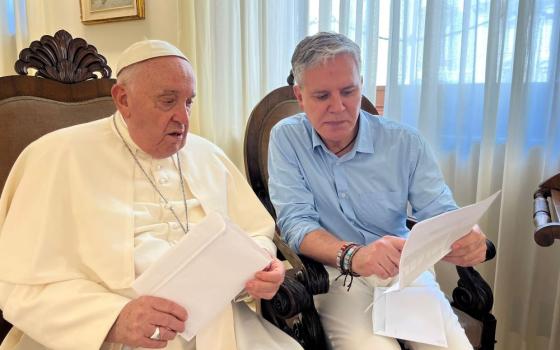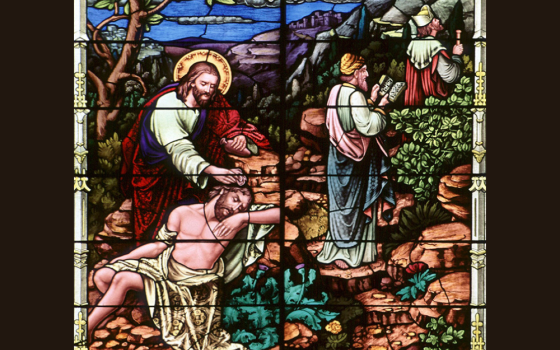Three years ago, in January 2019, residents of communities along Peru's Marañón River crammed into the sweltering meeting room that serves as the town hall in this small Amazonian city to hear government officials describe a plan to dredge, or deepen, parts of the Marañón and two other Amazonian rivers.
The goal, the officials said, was to make sure boats could travel the rivers all year round, even during extreme dry spells like droughts in 2004 and 2010, which made the transport of passengers and goods difficult or impossible as water levels dropped. The project would also include modern navigation aids, for nighttime travel. The way they described it, there were no downsides.
But not everyone in the audience was convinced. During the question-and-answer session, someone worried aloud that the dredging would eliminate the sand flats where people planted crops during the dry season. Another feared that dredging would increase river bank erosion, while a third said it might stir up sediment contaminated with oil or heavy metals from industrial runoff upstream. Still another added that the shallow spots filled with tangles of downed tree trunks might complicate navigation, but they were the best places for fishing.
Then two Kukama women stood up and voiced their own objection. Mari Luz Canaquiri and Emilsen Flores were from communities upriver and had participated in courses in their parish where the pastors — Spanish Augustinian Frs. Manolo Berjón and Miguel Angel Cadenas — talked about both pollution of the river and the importance of the Kukama culture. Canaquiri and Flores were also leaders of a women's organization, Huaynakana Kamatahuara Kana, which means "women who work" in the Kukama language.
Those shallow places, which the engineers considered "bad spots" to be eliminated so that large boats could pass, were the sand banks where river spirits rested, the two women said. If the shallow spots were dredged, the spirits would flee, and traditional healers who called on them for help would not be able to cure illnesses. Ultimately, they said, it would harm their people's health.
At the end of the hearing, the government official who summarized the public comments mentioned concerns about fishing, farming, erosion and contaminants, but said nothing about the river spirits. It seemed he had not even heard the women's words.
Undeterred, but tired of the threats to their river, from both the proposed dredging project and a series of spills from an aging oil pipeline, the women tried a different tactic. In September 2021, Huaynakana Kamatahuara Kana filed a legal action in court in Iquitos, Peru's largest Amazonian city, demanding that the Marañón be recognized as having rights — essentially, that it be considered a person.
Granting nature the right to thrive
The lawsuit is the first such case in Peru, although another is in the works, and is part of a movement that has been gaining momentum worldwide for more than a decade, as court rulings and legislation in countries as diverse as Bangladesh, Ecuador and New Zealand increasingly recognize that nature has rights. The rights of rivers' movement, in particular, is grounded not only in the importance of aquatic ecosystems, but also in their spiritual significance, especially for Indigenous peoples.
The movement to recognize nature as having the same legal rights as people is rooted in the belief that the Earth and its ecosystems have intrinsic value — that is, they are valuable in their own right, and not only because of what they are worth to humans who use or enjoy them.
Although the concept aligns closely with Indigenous worldviews, the modern legal movement in the U.S. dates back about half a century. In 1969, the Sierra Club filed a lawsuit against then-Interior Secretary Rogers Morton in an effort to stop the development of a ski resort in California's Mineral King Valley, which at the time was public land, but not part of a national park, as it is now.

Bicycling on the road to Mineral King, California, in 1972 (Wikimedia Commons/National Archives at College Park)
The environmental group argued that development would destroy the valley's natural beauty and aesthetic value — and that the group had the right to sue, because its purpose was to protect the environment. In a 1971 ruling, the U.S. Supreme Court upheld lower court rulings that the Sierra Club had not shown that it or its members would be harmed by the development. Three justices dissented, however, including Justice William Douglas, who wrote that the real plaintiff in the case was Mineral King Valley, and that the Sierra Club had sued on its behalf.
That idea took root more firmly the next year, when the late University of Southern California law professor Christopher Stone published a landmark law review article, "Should Trees Have Standing?: Towards Legal Rights for Natural Objects."
In his 1972 article, Stone argued that many other nonhuman things — including ships, corporations and nations — are considered "persons" under the law, so it is not unthinkable that elements of the natural world should have legal standing, too. And while a stream or a forest could not defend itself in court, humans could defend their interests as guardians, just as they do with people who cannot speak for themselves, such as infants or a patient in a coma.
"If you look back before that, there's many elements of rights of nature that show up, especially in Indigenous cultures — the idea of reciprocity between humans and nature, the idea that ecosystems are alive and not just human property, the idea that nature must be kept in a state of health and restored when harmed," said Grant Wilson of the Earth Law Center, an organization founded by Adrian Dominican Sr. Patricia Siemen that is dedicated to upholding the rights of nature.
Advertisement
Proponents of the rights-of-nature movement say environmental laws still tend to be human-centered, focusing on the harm done to humans by pollution, say, rather than the right of an ecosystem to be healthy. Opponents fret that giving nature legal standing would prohibit humans from ever cutting trees or extracting minerals, a view Stone rebutted in his article.
"All of nature, including rivers, is defined as human property under the legal system," Wilson told EarthBeat.
Granting a river the rights of a person, he added, "changes our relationship ... from one of owner and commander and exploiter to one of a co-inhabitant and shared rights holder. It's just a completely different dynamic."
What that means in practice varies from country to country, but a universal declaration of the rights of rivers, developed by the Earth Law Center and other civic groups, sets out some basic ones, including the right to flow, to be free from pollution, to perform essential ecosystem functions, and to regeneration and restoration.
"I do think that rivers have river rights and forests [have] forest rights and oceans have ocean rights, and they're all a little bit different," Wilson said. "But I think the overarching rights for all of nature are their rights not just to exist in a state of poor health, but to thrive, and a right to restoration."
'What is a river?'
Along the Marañón River, where thatch-roofed wooden houses are built on stilts to keep them above the high-water line during the rainy season, life centers around the snaking, café-con-leche-colored waterway. Peru's northeastern Loreto region has only one paved road, about 60 miles long, connecting Nauta with Iquitos. The only transportation connection with the rest of the country is by plane or by boat.

A woman washes clothes along the Marañón River in Peru's northeastern Loreto region. (Radio Ucamara)
The Marañón is not just a transport route, however. It also is the source of water for cooking, washing dishes and doing laundry. It provides food in a region where fish are the main source of protein. And it's a center of recreation, as children play in the water along the riverbanks, diving from canoes or tethered rafts, and adults cool off at the end of a long, hot day.
There is also a world within the river, as the Kukama believe that people who have fallen into the river and whose bodies have not been recovered did not drown, but went to live with river spirits in underwater cities. Pollution of the river, therefore, not only threatens the health of humans who live along its banks and the fish on which they depend for food, but it also endangers the welfare of those relatives and the river spirits.
In their legal case, which names half a dozen government agencies and the state-run oil company, the Kukama women say the Marañón and its tributaries merit legal personhood because of their intrinsic value, especially their spiritual value.
They demand the creation of a watershed management committee — required by law but never established — with the active participation of Indigenous communities. And they want the oil company to maintain and upgrade the pipeline, which has suffered scores of spills in recent decades.

A man tends his fishing net at sundown along the Marañón River in Peru. (Quisca Producciones/M. Araoz)
Recognizing that the Marañón has rights could also change the way people look at projects like the dredging proposal, which tend to view the river as merely a liquid highway, says Cadenas, former pastor of Santa Rita Parish upriver from Nauta. Cadenas is now bishop of Iquitos.
"Everyone has grand plans for the river," he said, "but no one bothers to ask, 'What is a river?' "
A river 'is many things'
One person who has an answer to that question is St. Joseph Sr. Makareta Tawaroa, who has spent most of her life near New Zealand's Whanganui River, which is sacred to her Maori people.
"Just outside my window, I can see the water in the midst of all the willow trees, and it's really only one part of a whole lot of other things. It's the flowing part, but it's also the hills and it's also the plants and the trees and the birds around it that really make it what it is, for me," Tawaroa told EarthBeat one morning in November.
"Yes, it's wet, it flows, it's liquid, but without all the other things around it, it would have less of a meaning for me," she added. "It's not one thing. It's many things. It's always been a natural part of our life, and it's hard to imagine being without it."
Half a world away from the Kukama women of Peru's Marañón Valley, Tawaroa and other Maori women waged a similar struggle, and in 2017 they won the battle to have the Whanganui, or Te Awa Tupua, the country's third-longest river, declared a person with rights.

An aerial view of the Whanganui River in New Zealand (Wikimedia Commons/Duane Wilkins)
The official declaration by the New Zealand government, which included an apology for historical wrongs committed against the Maori, recognized the river "as an indivisible and living whole," along its full length stretching from the mountains to the sea, as well as its tributaries "and all its physical and metaphysical elements." The government declaration added, "Reflecting the view of the River as a living and integrated whole, Te Awa Tupua will have its own legal personality with all the corresponding rights, duties and liabilities of a legal person."
The Whanganui was the first river on the planet to be recognized as a legal person, and the legislation drew attention from around the world.
Recalling a Maori elder who "saw the river as her mother, father, grandmother and grandfather," Tawaroa said, "It's always been a person to us, so I was surprised that that idea was new. It is an old idea."
Under the agreement, the river has Maori guardians to look out for its interests — an arrangement the women of the Marañón are also demanding. In New Zealand, the details are still being worked out, Tawaroa said, and it remains to be seen what impact the agreement will have on the river, which is affected by a hydroelectric dam near its headwaters and agricultural runoff along its 180-mile course.
Crucially, however, the legislation recognizes that the river is a system — not just a waterway of use to humans for transport, fishing or electricity, but a living entity made up of various elements, which has a spiritual and cultural significance for the people living along its banks.
Even those who have traveled away from the river carry it with them, Tawaroa said.

The Whanganui River runs through the city of Whanganui, New Zealand. (Pixabay/billiederamos)
"When we would leave home, we would be taken to the river, and our people would sprinkle us with the water," she said. "We would be blessed on our way, wherever we were going."
Struck by homesickness the first time she traveled away, Tawaroa recalled that, "in my mind's eye, I imagined the river, flowing down to my part and into the city, and that's how I was able to cope.
"I would think of home, and I would think of the river, because it linked me to all the villages. It linked me to all the people who had lived along the river. It linked me to so many things that I had forgotten. It was like a history book. It would tell me so much, just in closing my eyes and imagining the river."
Others have told her they do the same thing, she added. "When they're homesick, they close their eyes and they see the river in front of them."
'Personhood' of rivers questioned
At the press conference announcing the presentation of the legal case in Peru, a poster proclaimed, "El Río Marañón es un ser vivo" — "The Marañón River is a living being." That may be clear to the women who live along the banks of the Marañón and the Whanganui, but some lawyers do not agree.
During a virtual debate in October on the rights of nature, sponsored by the Gonzaga University Center for Climate, Society, and the Environment in Spokane, Washington, two legal experts outlined starkly different positions.

A poster proclaims that Peru's Marañón River is a living being. (Quisca Producciones and Radio Ucamara)
Wesley Smith, chair and senior fellow at the Center on Human Exceptionalism at the Seattle-based Discovery Institute, called the rights-of-nature movement "a primary threat to human thriving or prosperity, and a challenge to our self-concept as a species and the purpose and essential meaning of rights."
Human activities require the use of natural resources, he said, and giving nature the same rights as persons would bring development to a standstill.
Thomas Linzey, senior legal counsel at the Center for Democratic and Environmental Rights in Spokane and a pioneer in the rights-of-nature movement, countered that pollution, deforestation, loss of biodiversity and shrinking wildlife habitat show that "we're in a crisis moment, and we have an environmental law system that's incapable of dealing with that."
Under the Western legal system, "Nature is property or a thing that can be owned," Linzey said, and "because it's property ... the more nature you own, the more that you can destroy."
That system recognizes corporations as legal persons — recognition expanded by the U.S. Supreme Court in recent years — so giving nature or a river the same rights injects balance into the system, he added. It also echoes the Indigenous worldview that sees nature not as "something that can be owned, but something animated and connected to people and communities."

Kayaks are seen along the Whanganui River in Whanganui National Park, New Zealand. (Dreamstime/Blagov58)
The question, Linzey continued, is "no longer can nature have rights under the system. The challenge is to craft these laws to make sure they give us the tools that we need to protect the environment and ourselves."
That argument is also reflected in Pope Francis' 2015 encyclical, "Laudato Si', on Care for Our Common Home," Wilson of the Earth Law Center told EarthBeat.
In that document, Francis "recognizes the inherent value of the natural world, that it's not just resources to be exploited," he said. "That philosophy — that nature is not just something that humans dominate and can exploit, and that nature has inherent value — is an underpinning, if not the underpinning, of the rights of nature movement."
The natural world — especially water — holds a special place in Christian tradition, as well, said Mercy Sr. Kathleen Rushton, who grew up along a braided river system in lowlands near Christchurch, New Zealand.
"If we go back to the creation story, the Spirit hovered over the deep, over the waters, and life [arose]. Water and life are connected," she told EarthBeat, adding that the psalms and other biblical passages are filled with water imagery.
"In our prayer, reflection and study of Scripture, we need to allow Jesus to walk in sandals on the Earth," she said. "He actually is on the Earth and very much linked with the land and with water."

The Whanganui River between Matahiwi and Jerusalem, New Zealand (Wikimedia Commons/Prankster)
For Tawaroa, the spiritual connection of Indigenous people with their rivers is clear.
"We still take our water spirits seriously — they are part of our spirituality, our theology. They are embraced. They are part of the communion of saints," she said. "We embrace them all, because they show us another aspect of — call it what you will. God is many names, yet is beyond description. So how do we embrace all that?"






